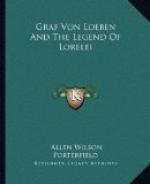[73] In reply to a letter addressed to Professor Elster
on October 4,
1914, the writer received
the following most kind reply on
November 23: “Die
Frage, die Sie an mich richten ist leicht
beantwortet: Heine hat
Loeben in seinen Schriften nicht erwAehnt,
aber das besagt nicht viel;
er hat manchen benutzt, den er nicht
nennt. Und es kann gar
keinem Zweifel unterliegen, dass
Loeben fUer die Lorelei Heines
unmittelbares Vorbild ist;
darauf habe ich Oefter hingewiesen,
aber wohl auch andere. Das
Taschenbuch Urania
fUer das Jahr 1821, wo Loebens Gedicht
u. Novelle zuerst erschienen,
ist unserem Dichter zweifellos zu
Gesicht gekommen.”
No one can view Professor Elster in any other
light than as an eminent authority
on Heine, but his certainty
here must be accepted with
reserve, and his “wohl auch andere” is,
in view of the fact that,
he was by no means the first, and
certainly not the last, to
make this assertion, a trifle
disconcerting.
[74] The ultimate determining of sources is an ungrateful
theme. Some
excellent suggestions on this
subject are offered by Hans Rohl in
his Die Aeltere Romantik
und die Kunst des jungen Goethe,
Berlin, 1909, pp. 70-72.
This work was written under the general
leadership of Professor Elster.
The disciple would, in this case,
hardly agree with the master.
Pissin likewise speaks wisely in
discussing the influence of
Novalis on Loeben in his monograph on
the latter, pp. 97-98. and
129-30. And Heine himself (Elster
edition, V. 294) says in regard
to the question whether Hegel did
borrow so much from Schelling:
“Nichts ist lAecherlicher als das
reklamierte Eigentumsrecht
an Ideen.” He then shows how the ideas
were not original with Schelling
either; he had them from
Spinoza. And it is just
so here. Brentano started the legend;
Heine goes back to him indirectly.
Eichenidorff and Vogt directly;
Schreiber borrowed from Vogt,
Loeben from Schreiber, and Heine
from Schreiber—and
thereafter it would be impossible to say who
borrowed from whom.
[75] The majority of the Loreleidichtungen
can be found in:
Opern-Handbuch, by
Hugo Riemann, Leipzig, 1886: Zur
Geschichte der MAerchenoper,
by Leopold Schmidt, Halle, 1895;
Die Loreleysage in Dichtung
und Musik, by Hermann Seeliger,
Leipzig, 1898. Seeliger
took the majority of his titles from
Nassau in seinen Sagen,
Geschichten und Liedern, by
Henniger, Wiesbaden, 1845.
At least he says so, but one is
inclined to doubt the statement,
for “die meisten Balladen” have
been written since 1845.
Seeliger’s book is on the whole
unsatisfactory. He has,
for example, Schreiber improving on, and
remodeling Loeben’s
saga; but Schreiber was twenty-three years
older than Loeben, and wrote
his saga at least three years before
Loeben wrote his.




